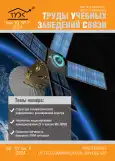No-Reference Image Quality Assessment Algorithm
- Authors: Gritskevich I.Y.1, Gogol A.A.1
-
Affiliations:
- The Bonch-Bruevich Saint-Petersburg State University of Telecommunications
- Issue: Vol 10, No 2 (2024)
- Pages: 16-23
- Section: ELECTRONICS, PHOTONICS, INSTRUMENTATION AND COMMUNICATIONS
- URL: https://journals.rcsi.science/1813-324X/article/view/255941
- EDN: https://elibrary.ru/TTPABW
- ID: 255941
Cite item
Full Text
Abstract
About the authors
I. Yu. Gritskevich
The Bonch-Bruevich Saint-Petersburg State University of Telecommunications
Email: i@robotace.ru
ORCID iD: 0009-0007-4916-1816
SPIN-code: 9840-3941
A. A. Gogol
The Bonch-Bruevich Saint-Petersburg State University of Telecommunications
Email: agogol@sut.ru
ORCID iD: 0000-0003-1972-4124
SPIN-code: 2002-9651
References
- Грицкевич И.Ю., Ерганжиев Н.А. Алгоритм адаптивного контрастирования с учетом локальных сюжетных осо-бенностей изображения // V Международная научно-техническая конференция, посвященная 140-летию со дня рождения выдающегося физика и создателя первой русской усилительной радиолампы Н.Д. Папалекси «Актуальные проблемы радио- и кинотехнологий» (Санкт-Петербург, Россия, 24–25 ноября 2020). СПб.: Санкт-Петербургский государственный институт кино и телевидения, 2021. С. 36−40. EDN:DNBFGB
- Гонсалес Р., Вудс Р. Цифровая обработка изображений. М.: Техносфера, 2006. 1072 с.
- Красильников Н.Н. Цифровая обработка 2D- и 3D-изображений. СПб.: БХВ-Петербург, 2011. 608 с.
- Сифоров В.И., Ярославский Л.П. Адаптивные методы обработки изображений. М.: Наука, 1988. 248 с.
- Начаров Д.В. Метод контрастирования изображений средствами модифицированного S-образного преобразования яркости // Вестник Воронежского государственного технического университета. 2023. Т. 19. № 2. С. 94–102. doi: 10.36622/VSTU.2023.19.2.014. EDN:XEUQGW
- Умбиталиев А.А., Цыцулин А.К., Левко Г.В., Пятков В.В., Кузичкин А.В., Дворников С.В. и др. Теория и практика космического телевидения. СПб: АО «НИИ телевидения», 2017.
- Suckling J., Parker J., Dance D., Astley S., Hutt I., Boggis C., et al. The mammographic Image Analysis Society Digital Mammogram Database // Exerpta Medica. International Congress Series. 1994. Vol. 1069. PP. 375−378.
- Van Ginneken B., Romeny B.M.T.H. Computer-aided diagnosis in chest radiography: a survey // IEEE Transactions on Medical Imaging. 1998. Vol. 20. Iss. 12. PP. 1228−1241. doi: 10.1109/42.974918
- Karssemeijer N., Otten J.D.M., Rijken H., Holland R. Computer aided detection of masses in mammograms as decision support // IEEE Transactions on Medical Imaging. 1993. Vol. 12. Iss. 4. PP. 608−615.
- Wang Z., Wu G., Bovik A.C. Reduced and No-Reference Image Quality Assessment // IEEE Signal Processing Magazine. 2011. Vol. 28. Iss. 6. PP. 29−40. doi: 10.1109/MSP.2011.942471
- Seshadrinathan K., Bovik A.C. Video Quality Assessment // In: Essential Guide to Video Processing. New York: Academic, 2009.
- Bovik A.C., Wang Z. Modern Image Quality Assessment. New York: Morgan and Claypool, 2006.
- Sheikh H.R., Bovik A.C., De Veciana G. An information fidelity criterion for image quality assessment using natural scene statistics // IEEE Transactions on Image Processing. 2005. Vol. 14. Iss. 12. PP. 2117–2128. doi: 10.1109/TIP.2005.859389
- Rec. ITU-R BT.500-11 (2002) Methodology for subjective assessment of the quality of television pictures.
Supplementary files






